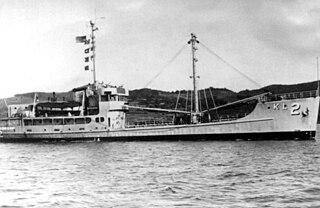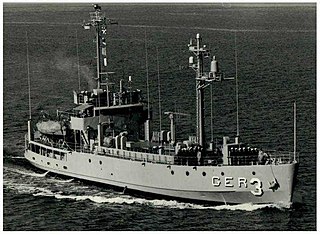
USS Estero (AG-134/AKL-5) was a Camano-class cargo ship in the United States Navy. She was named after Estero Island off the coast of Florida.
USS Camano (AG-130/AKL-1) was an Army Design 381 coastal freighter acquired by the United States Navy 16 July 1947 at Apra Harbor, Guam and became the lead ship of her class of cargo ship. She was configured as a Navy transport and cargo ship and operated with the U.S. Pacific Fleet until 1951, when she was turned over to the U.S. Department of the Interior.

USS Deal (AG-131/AKL-2) was constructed for the U.S. Army as U.S. Army FS-263 shortly before the end of World War II and later acquired by the U.S. Navy in 1947. She was configured as a transport and cargo ship, classed by the Navy as a Camano-class cargo ship and operated with the U.S. Pacific Fleet from post-World War II and on through the end of the Korean War.
USS Elba (AG-132/AKL-3) was a Camano-class cargo ship constructed for the U.S. Army as USA FS-267 shortly before the end of World War II and later acquired by the U.S. Navy in 1947. She was configured as a transport and cargo ship and was assigned to serve the World War II Trust Territories in the Pacific Ocean.
USS Errol (AG-133/AKL-4) was a Camano-class cargo ship constructed for the U.S. Army as USA FS-274 shortly before the end of World War II and later acquired by the U.S. Navy in 1947. She was configured as a transport and cargo ship and was assigned to serve the World War II Trust Territories in the Pacific Ocean.
USS Roque (AG-137/AKL-8) was a Camano-class cargo ship constructed for the U.S. Army as USA FS-347 shortly before the end of World War II and later acquired by the U.S. Navy in 1947. She was configured as a transport and cargo ship and was assigned to serve the World War II Trust Territories in the Pacific Ocean.
USS Ryer (AG-138/AKL-9) was a Camano-class cargo ship constructed for the U.S. Army as the Freight and Supply Ship USA FS-361 shortly before the end of World War II. On delivery the ship was U.S. Coast Guard crewed and assigned to serve the Southwest Pacific area during the war. The ship was acquired by the U.S. Navy in 1947, configured as a transport and cargo ship, named and was Commissioned, Miscellaneous Auxiliary, USS Ryer (AG-138), 8 June 1947 and reclassified Light Cargo Ship, (AKL-9), 31 March 1949.

USS Sharps (AG-139/AKL-10) was a Camano-class cargo ship constructed for the U.S. Army as USA FS-385 shortly before the end of World War II and later acquired by the U.S. Navy in 1947. She was configured as a transport and cargo ship and was assigned to serve the World War II Trust Territories in the Pacific Ocean. She later served with distinction in the Korean War.

USS Hewell (AG-145/AKL-14) was a Camano-class cargo ship constructed for the U.S. Army as FS-391 shortly before the end of World War II. FS-391 operated with a U.S. Coast Guard crew in the Southwest Pacific area. The ship was acquired by the U.S. Navy in 1948. She was configured as a transport and cargo ship and served with the U.S. Pacific Fleet – including highly decorated service during the Korean War – until decommissioned in 1955.

USNS Range Recoverer (T-AG-161/T-AGM-2/YFRT-524) was a missile range instrumentation ship responsible for providing radar and/or telemetry track data on missiles launched from American launch sites.

U.S. Army FS-255 was one of the U.S. Coast Guard-manned U.S. Army Freight and Supply (FS) ships of World War II.

USNS New Bedford (FS-289/AKL-17) was a Navy owned Military Sea Transportation Service civilian crewed Camano-class cargo ship originally constructed for the U.S. Army as the coastal freighter FS-289 shortly before the end of World War II.

The USS Banner was originally U.S. Army FS-345 serving in the Southwest Pacific during the closing days of World War II as one of the Army's United States Coast Guard crewed ships. In 1950 the ship was acquired by the Navy and converted into a light auxiliary cargo (AKL). In 1967 the ship was converted for electronic intelligence and reclassified as Auxiliary General Environmental Research (AGER).

USS Palm Beach (AGER-3) was a former Army Auxiliary Aircraft Repair Ship converted to an electronic and signals intelligence ship of the United States Navy.

The Banner class was a class of three environmental research ships converted from Camano-class cargo ships by the United States Navy during the 1960s. The class comprised three ships: Banner, Pueblo, and Palm Beach. The ships were originally United States Army vessels, which had been built in 1944. Although officially classified as environmental research ships, they were actually used for signals intelligence gathering, as part of the AGER program.
USS Torry (AKL-11) was a Camano-class cargo ship of the United States Navy. During World War II, she previously served as the United States Army Transport FS-394. After being acquired by the United States Navy, the ship was commissioned as USS Torry (AG-140), but was later reclassified as a light cargo ship. On 29 January 1952, she was transferred to the Department of the Interior and was sold to Socony-Mobil in 1961. The ship was successively sold to several companies before becoming a fishing vessel and was scuttled in 2015 off the coast of Delaware as an artificial reef.

USS Brule (AKL-28) was a U.S. Army Design 381-A Coastal Freighter of the United States Navy and later the South Korean Navy that saw service during World War II, the Korean War, and the Vietnam War.

NOAAS George B. Kelez, previously NOAAS George B. Kelez, was an American research vessel in commission in the National Oceanic and Atmospheric Administration (NOAA) fleet from 1972 to 1980. Prior to her NOAA career, she operated under the United States Fish and Wildlife Service′s Bureau of Commercial Fisheries from 1962 to 1970 as US FWS George B. Kelez and the National Marine Fisheries Service from 1970 to 1972 as NOAAS George B. Kelez.

US FWS Dennis Winn was an American cargo liner in commission in the fleet of the United States Fish and Wildlife Service from 1948 to 1960. She frequently provided a passenger and cargo service to and from the Pribilof Islands, and also carried passengers and cargo to and between other communities and FWS stations in the Territory of Alaska. Prior to her fisheries service, she was the United States Army cargo ship U.S. Army Lt. Walter J. Will (FS-244).













